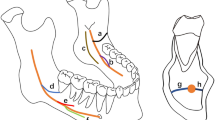Abstract
Purpose
The knowledge of the variation in the mandibular foramen and canal is clinically significant in surgical procedures of the mandible. This study aims to evaluate the anatomical characteristics of double mandibular foramen leading to the accessory canal on the mandibular ramus using cone beam CT.
Methods
The sagittal, cross-sectional, and three-dimensional images of cone beam CT data from 446 patients were evaluated in the presence of double mandibular foramen and the accessory canal passing through the foramen. The accessory canals were classified into two types according to the configuration (forward and retromolar type), and the location of double mandibular foramen was recorded.
Results
The eight double mandibular foramina leading to the accessory canals were observed in six patients out of 446 patients (1.35 % of population). Regarding the configuration of the accessory canal, there were two forward types and six retromolar types. All double mandibular foramina were located above the mandibular foramina on the medial aspect of the mandibular ramus.
Conclusion
Three-dimensional images of cone beam CT data are useful in confirming the presence of double mandibular foramen leading to the accessory canal. The variation may cause failure in the routine mandibular nerve block anesthesia and it is often vulnerable during surgical procedures involving the mandibular ramus. Also, double mandibular foramen is considered as an easy route for tumor cell to spread following the radiotherapy. Therefore, the variation should be carefully investigated using reconstructed cone beam CT images in planning of dental surgery or radiotherapy in the mandible.



Similar content being viewed by others
References
Chavez-Lomeli ME, Mansilla Lory J, Pompa JA, Kjaer I (1996) The human mandibular canal arises from three separate canals innervating different tooth groups. J Dent Res 75(8):1540–1544
Das S, Suri RK (2004) An anatomico-radiological study of an accessory mandibular foramen on the medial mandibular surface. Folia Morphol (Warsz) 63(4):511–513
Daw JL Jr, de la Paz MG, Han H, Aitken ME, Patel PK (1999) The mandibular foramen: an anatomic study and its relevance to the sagittal ramus osteotomy. J Craniofac Surg 10(6):475–479
de Oliveira Junior MR, Saud AL, Fonseca DR, De-Ary-Pires B, Pires-Neto MA, de Ary-Pires R (2011) Morphometrical analysis of the human mandibular canal: a CT investigation. Surg Radiol Anat 33(4):345–352
Fanibunda K, Matthews JN (2000) The relationship between accessory foramina and tumour spread on the medial mandibular surface. J Anat 196(Pt 1):23–29
Fuakami K, Shiozaki K, Mishima A, Shimoda S, Hamada Y, Kobayashi K (2011) Detection of buccal perimandibular neurovascularisation associated with accessory foramina using limited cone-beam computed tomography and gross anatomy. Surg Radiol Anat 33(2):141–146
Han SS, Hwang YS (2014) Cone beam CT findings of retromolar canals in a Korean population. Surg Radiol Anat. doi:10.1007/s00276-014-1262-1
Hur MS, Kim HC, Won SY, Hu KS, Song WC, Koh KS, Kim HJ (2013) Topography and spatial fascicular arrangement of the human inferior alveolar nerve. Clin Implant Dent Relat Res 15(1):88–95
Kawai T, Asaumi R, Kumazawa Y, Sato I, Yosue T (2014) Observation of the temporal crest canal in the mandibular ramus by cone beam computed tomography and macroscopic study. Int J Comput Assist Radiol Surg. doi:10.1007/s11548-013-0931-6
Kuribayashi A, Watanabe H, Imaizumi A, Tantanapornkul W, Katakami K, Kurabayashi T (2010) Bifid mandibular canals: cone beam computed tomography evaluation. Dentomaxillofac Radiol 39(4):235–239
Langlais RP, Broadus R, Glass BJ (1985) Bifid mandibular canals in panoramic radiographs. J Am Dent Assoc 110(6):923–926
Lew K, Townsen G (2006) Failure to obtain adequate anaesthesia associated with a bifid mandibular canal: a case report. Aust Dent J 51(1):86–90
Manikandhan R, Mathew PC, naveenkumar J, Anatanarayanan P (2010) A rare variation in the course of the inferior alveolar nerve. Int J Oral Maxillofac Surg 39:185–187
Monnazzi MS, Passeri LA, Gabrielli MF, Bolini PD, de Carvalho WR, da Costa Machado H (2012) Anatomic study of the mandibular foramen, lingula and antilingula in dry mandibles, and its statistical relationship between the true lingula and the antilingula. Int J Oral Maxillofac Surg 41(1):74–78
Naitoh M, Hiraiwa Y, Aimiya H, Ariji E (2009) Observation of bifid mandibular canal using cone-beam computerized tomography. Int J Oral Maxillofac Implants 24(1):155–159
Naitoh M, Nakahara K, Suenaga Y, Gotoh K, Kondo S, Ariji E (2010) Variations of the bony canal in the mandibular ramus using cone-beam computed tomography. Oral Radiology 26(1):36–40
Narayana K, Prashanthi N (2003) Incidence of large accessroy mandibular foramen in human mandibles. Eur J Anat 7(3):139–141
Nortje CJ, Farman AG, Grotepass FW (1977) Variations in the normal anatomy of the inferior dental (mandibular) canal: a retrospective study of panoramic radiographs from 3612 routine dental patients. Br J Oral Surg 15(1):55–63
Orhan K, Aksoy S, Bilecenoglu B, Sakul BU, Paksoy CS (2011) Evaluation of bifid mandibular canals with cone-beam computed tomography in a Turkish adult population: a retrospective study. Surg Radiol Anat 33(6):501–507
Ossenberg NS (1986) Temporal crest canal: case report and statistics on a rare mandibular variant. Oral Surg Oral Med Oral Pathol 62(1):10–12
Ossenberg NS (1987) Retromolar foramen of the human mandible. Am J Phys Anthropol 73(1):119–128
Patil S, Matsuda Y, Nakajima K, Araki K, Okano T (2013) Retromolar canals as observed on cone-beam computed tomography: their incidence, course, and characteristics. Oral Surg Oral Med Oral Pathol Oral Radiol 115(5):692–699
Patil S, Matsuda Y, Okano T (2013) Accessory mandibular foramina: a CT study of 300 cases. Surg Radiol Anat 35(4):323–330
Przystanska A, Bruska M (2010) Accessory mandibular foramina: histological and immunohistochemical studies of their contents. Arch Oral Biol 55(1):77–80
von Arx T, Hanni A, Sendi P, Buser D, Bornstein MM (2011) Radiographic study of the mandibular retromolar canal: an anatomic structure with clinical importance. J Endod 37(12):1630–1635
Conflict of interest
The authors declare no conflict of interest.
Author information
Authors and Affiliations
Corresponding author
Rights and permissions
About this article
Cite this article
Choi, YY., Han, SS. Double mandibular foramen leading to the accessory canal on the mandibular ramus. Surg Radiol Anat 36, 851–855 (2014). https://doi.org/10.1007/s00276-014-1310-x
Received:
Accepted:
Published:
Issue Date:
DOI: https://doi.org/10.1007/s00276-014-1310-x




